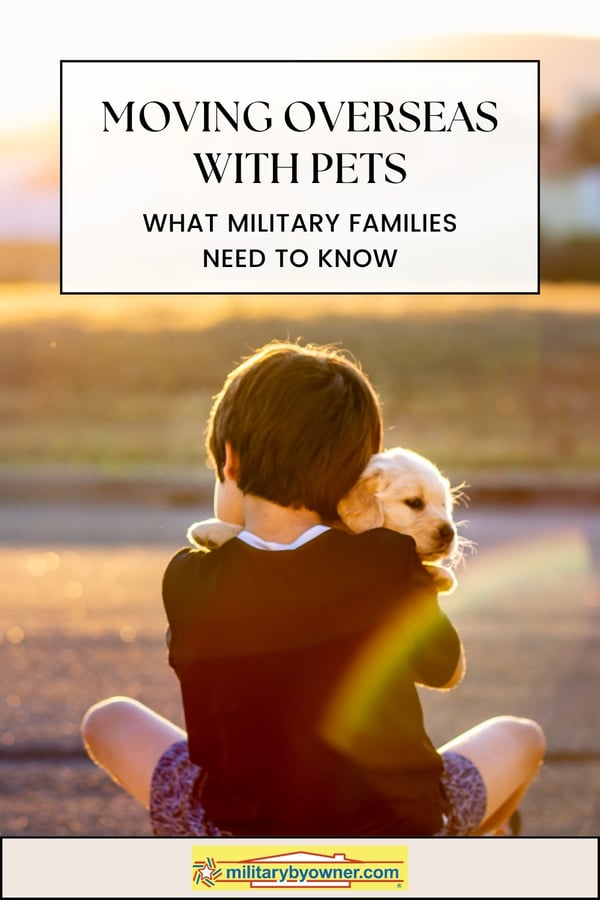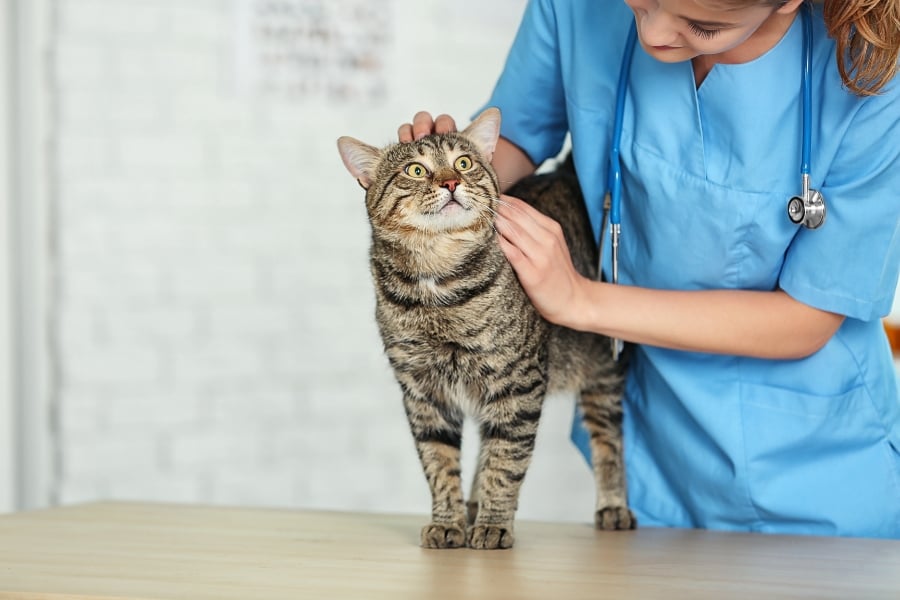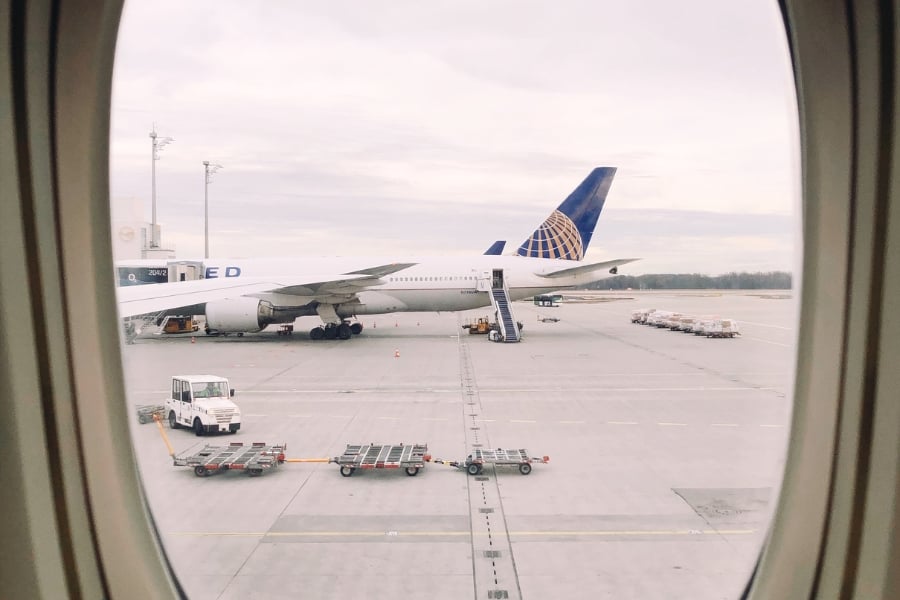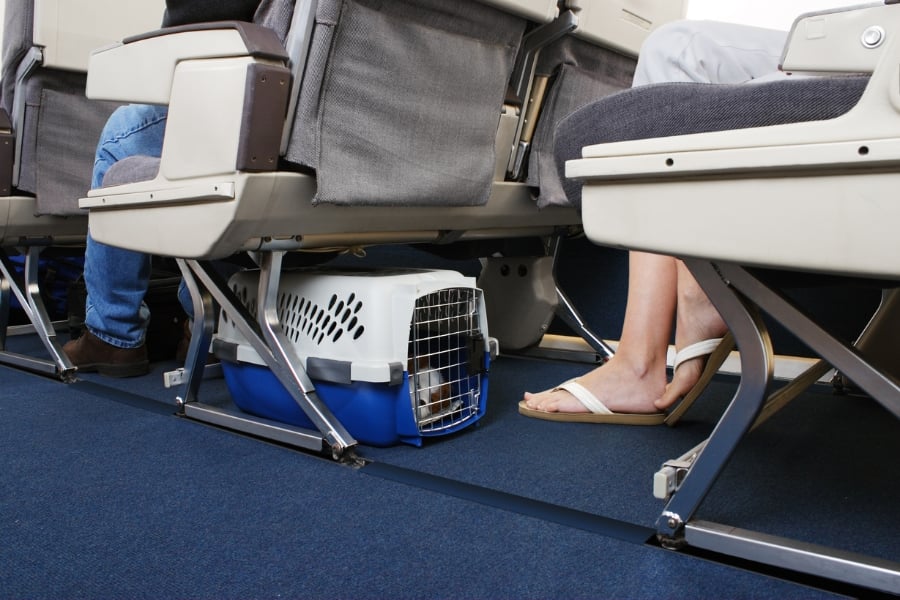Moving Overseas with Pets: What Military Families Need to Know
Getting orders for an overseas (OCONUS) move is the beginning of an exciting journey for military members and their families, but it also requires meticulous planning.
If you have a furry friend in the family, it adds an extra layer of complexity to your PCS move. Here's what military families need to know to know about moving with pets and international pet travel, including specific regulations for popular OCONUS duty stations.

What Military Families Should Know About an International Move with Pets
The military offers resources to aid service members with their international moves. Assigned sponsors are there to ease the transition, but pet concerns can often be overlooked. Until recently, there was little to no financial compensation for pet travel, but as of January 1, 2024, there is a new pet transportation allowance for military moves.
But if you’ve ever moved with a pet internationally, you know that this allowance may not cover moving your pets completely, not to mention the amount of research required for each country's differing regulations. It’s this amount of time and money required that causes many military members to leave their pets with family members while OCONUS.
Each country has overseas pet quarantine regulations that extend beyond the standard health certificate and pet examinations. Even the United States requirements vary as soon as you leave the continental U.S. Take Hawaii and Guam, for example.
Moving to Hawaii with Pets
Hawaii is a rabies-free state, which means that the state requires that pets must be rabies-free, up to date on current vaccines, and quarantine for 120 days, which can take place prior to arrival if certain requirements are met. Note that cats and dogs not meeting these requirements will be quarantined up to 120 days on arrival. Learn more at Hawaii.gov.
There are varying checklists depending on which island you are PCSing to; however, Oahu is the most common, and their direct release or the five-day program checklist (no quarantine required) is as follows:
- Microchip: Your dog or cat must have an implanted microchip. It must be implanted before the FAVN antibody test is completed (more on this below).
- Rabies vaccine: Your pet must have received at least two rabies vaccines in their life, at least 30 days apart. The current rabies vaccine must be administered at least 30 days prior to arrival in Honolulu and be within the manufacturer’s expiration date. You must have the rabies vaccine certificates.
- FAVN Rabies Antibody Test: The FAVN test must be conducted within 36 months but more than 30 days prior to arriving in Hawaii. “Hawaii” should be listed as the destination on the lab submission form, and the blood test should be sent to an approved lab (see State of Hawaii Animal Quarantine Information for more info). Test results should be greater than or equal to 0.5 IU/ml.
- 30-Day Waiting Period: The day after the lab receives the test starts the “in-home quarantine” phase. If your pet arrives in Honolulu before 30 days have passed after the lab receives the blood sample, your pet will not be eligible for direct release.
- Payment: You must have a money order or cashier’s check for the AQO (Animal Quarantine Office).
- Health certificate: Pets must have a health certificate, within 14 days of traveling, from a veterinarian after evaluating your pet for heartworms, parasites, and fitness to travel.
The application form (Dog & Cat Import Form ASQ-279), two original rabies certificates (signed in ink), and payment must be sent to the AQO at least 10 days prior to arrival.

Photo from Canva
Moving to Guam with Pets
Guam requires a 120-day quarantine for animals coming to the island.
- Application: The application, along with a money order for each animal permit and pet license (annual), must accompany your application.
- Affidavit for Export: For animals leaving a rabies-free area such as Japan or Hawaii, you can obtain a certificate from your veterinarian stating that your pet did not leave the rabies-free area four months prior to anticipated travel to Guam.
- Vaccines: Cats and dogs must have received at least two rabies vaccines in their lifetime, with the most recent one being current but not administered within four months of arrival (if it’s the modified live rabies vaccine) or within 10 days of travel for other vaccines.
- Microchip: Your animal must have a readable microchip, and the number must be listed on all related testing and vaccine certificates.
- OIE-FAVN Test: The FAVN test must be administered no more than 12 months prior to travel to Guam. The day that the approved lab receives the test starts the 120-day countdown. Test results should be greater than or equal to 0.5 IU/ml.
- Health certificate: Pets must have a health certificate, within 14 days of traveling, from a veterinarian after evaluating your pet for heartworms, parasites, and fitness to travel.
Failure to meet these requirements will result in your pet being placed in quarantine for however many remaining days they need to meet the 120-day quarantine requirement. Kennel fees are at the owner’s expense.
For more information on importing pets to Guam, visit the Customs & Quarantine Agency Government of Guam website.

Photo from Canva
Travel further from the U.S. and you’ll find differing regulations regarding pets. Below, we're covering some popular OCONUS duty stations.
Moving to Japan with Pets
Much like Hawaii and Guam, Japan is rabies-free and has stricter requirements regarding pet importation, mandating 180-day quarantines after the FAVN test prior to arrival.
- Microchip: Your pet must have a readable microchip.
- Vaccines: Your pet must have at least two rabies vaccines. Japan does not recognize any rabies vaccine that was given before 91 days of age or before they were microchipped. Additionally, they don’t authorize three-year rabies vaccines like the United States does. The vaccines must be given at least 30 days apart and within the effective period of the first. The most recent rabies vaccine must still be current upon arrival in Japan.
- FAVN: Rabies antibody test must be sent to an approved laboratory. Test results should be greater than or equal to 0.5 IU/ml.
- 180- day waiting period: The day the blood is drawn for the FAVN is day 0. You must wait 180 days before your pet can arrive and be directly released in Japan.
- Notice: You must provide advanced notice 40 days prior to your pets arrival in Japan.
- Health certificate: Pets must have a health certificate, within 14 days of traveling, from a veterinarian after evaluating your pet for heartworms, parasites, and fitness to travel.
For more information, check Import Dogs and Cats into Japan or contact the Kadena Veterinary Clinic for questions specific to importing pets via the rotator.
Moving to the UK and Germany with Pets
While more lenient than in the Pacific, the United Kingdom and Germany have several requirements before your pet can arrive in the country, including a 21-day waiting period.
- Microchip: The pet must have an ISO-compliant microchip. If they already have a non-ISO chip implanted, you can travel with your own reader.
- Rabies vaccine: Your pet must have received two or more rabies vaccines. The first vaccine administered after the microchip is implanted is the “primary vaccine,” and can be done on the same day as implantation, but is only valid for one year. Every subsequent rabies vaccine is valid for as long as the manufacturer states, either one, two, or three years, and is given without a lapse from the primary vaccine.
- Tapeworm treatment: Dogs traveling to the UK must be given tapeworm treatment by a USDA-approved veterinarian.
- 21-day waiting period: The waiting period begins the day that your pet is given the primary rabies vaccine.
- Health certificate: A USDA-approved or military veterinarian must examine your pet and generate a health certificate. Once signed, the certificate is valid for 30 days. However, it must be countersigned and endorsed by APHIS or a military veterinarian within 10 days of arriving in Europe.
- Declaration: The final page of the EU or UK health certificate is a declaration that you need to complete and sign before traveling to the country.
A European Union (EU) Pet Passport is available for those traveling with their pet within Europe. For example, if you’re stopping in France for a little sightseeing on your way to the UK or Germany, your pet will need a pet passport.
For more information on importing your pet to the UK or Germany, visit the U.S. Department of Agriculture below:
- Information on moving to the UK with a pet
- Information on moving to Germany with a pet

Photo from Canva
How to Move Your Pets Overseas
1. Fly on the Patriot Express.
Getting your pet booked on the rotator overseas is difficult, as there are few spots. However, if you’re able to secure a reservation for them, it’s by far the least expensive route to get your pet OCONUS with you. Unfortunately, these flights are not available for those transferring overseas for embassy duty.
2. Book commercial.
Commercial flights are the most popular option for pet travel when available because there’s often more availability than the Patriot Express, it's less expensive than pet shippers, and it keeps your pet on your timeline. Military spouse Lesley shares her family's experience:
“If you end up on a commercial flight, make sure to have the airline's official policy accessible, because many times, their own employees don't know it and will try to tell you that you can't fly with a pet. We had to speak to three different managers checking in with Delta in Atlanta because they were convinced they don't fly any animals (they do).”
Note: Be mindful of snub nose breeds such as boxers, bull dogs, and frenchies as they can only fly during certain months of the year (and sometimes not at all) due to heat embargoes and ground transportation. Keep in mind that these breeds often cost more to ship as well.
3. Use a pet travel company.
If you can’t secure the rotator or a commercial flight for your pet, or you simply don’t have the bandwidth to coordinate getting your pet overseas, some companies will do it for you. Take Allison, who moved from North Carolina to Oahu, for example:
“We used Island Pet Movers who were hugely helpful in coordinating everything—it would have been way too much on our own. We ground shipped both of our dogs to LAX, then they flew cargo on a temp-controlled plane to the island. IPM handled pickup and paperwork and delivered to our door on base. Less than two years later, we had to do it in reverse, only we shipped them out ahead of us. Luckily, my father-in-law was able to receive them in GA and keep them until we arrived a month later. Our out of pocket was nearly $10k for shipping on and back off island when all was said and done.”
4. Secure a charter.
There are social groups and sites designated to network people actively trying to move their beloved pets overseas and back. From milspouse Kelly:
“These groups organize private jet flights facilitated by a broker, where one owner or designated individual accompanies the pet in the cabin from the U.S. to the U.K. The cost varies based on the number of people involved in each flight, but you can expect the price to range from $7,000 to $9,000. It’s expensive, but ideal for families traveling during extreme hot or cold months or for those with anxious pets who would not handle flying in cargo well like our dog. This was the only option to have him join us in England.”
Even with careful planning and research, moving your pet overseas might be the priciest part of your OCONUS PCS. However, it’s often worthwhile for military families to bring their pets to help smooth the transition at their new duty station.





